 |
 |
|
 |
 |
The 85th in France - Official Unit History
Landing in France
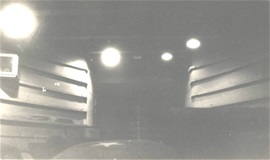 Inside an LST on the way to France
Inside an LST on the way to France
The battalion arrived at the Gulf of St. Tropez, France at 1400 9 September 1944. Unloading of vehicles and personnel started at 1500 and was completed at 0700
10 September 1944. The vehicles and personnel debarking proceeded to vicinity of Cogolin, France and established a bivouac area.
The 10th of September 1944 was spent obtaining gasoline and rations for the move to the vicinity of Seventh Army Headquarters
which was located in Lons Le Saunier, France. Strip maps of the route were prepared and issued to all drivers. All preparations were completed and orders were issued stating that the battalion would move at 0500 11 September 1944.
Lt. Allen and
5 enlisted men from Headquarters departed at 0430 11 September as the Advance Party for the convoy.
Lt. Col. L. A. Perdue, Battalion Commanding Officer and Capt. W. E. Nagel, departed 0530 on another route to contact Engineer Section of Seventh
Army to obtain the location of the battalion bivouac area.
The convoy was commanded by Capt. R. L. Porter, Executive Officer. The battalion convoy consisted of 13 serials, each serial leaving at 15 minute intervals. The first serial departed at
0500 11 September 1944. The first serial arrived in the vicinity of Aspres sur Buech, France at 1500. The trail unit arrived at 0400 12 September 1944. Distance traveled during the first day was 190 miles.
The organization departed from Aspres sur
Buech, France 0600 12 September 1944 by motor convoy. The first serial arrived at 1500 in vicinity of St. Germain Les Arles, France. The distance traveled for second day was 200 miles. Upon arrival, the bivouac area was set up and vehicles were refueled and
first echelon maintenance performed. The trail unit was delayed because of mechanical failures of three vehicles. At 1700, verbal orders were received from Lt. Col. King of the Engineer Section, Seventh Army, stating that the battalion was to move the next
day to vicinity of Dole, France. All preparations were made to have the battalion ready to move by 1300 13 September 1944. - 9/13/44 U.S. troops reach the Siegfried Line. Capt. R. L. Porter with a detail and a bulldozer departed at 0900 13 September
1944 to locate and prepare a bivouac area offering concealment and camouflage.
The battalion, less the trail unit, departed from the vicinity of St. Germain Les Arles, France 1300 13 September by motor convoy. The convoy arrived in the vicinity
of La Vielle Loye, France at 1600. The distance traveled was 35 miles. Upon arrival, the battalion set up a bivouac area observing all the necessary rules of camouflage discipline. All vehicles were dispersed and well camouflaged. The trail unit arrived at
2300.
On September 14, 1944, the battalion received orders from the Engineer Section, Seventh Army to have an Officer inspect and inventory the German Ponton Equipment on railroad north of Auxonne, France. Lt. Hunt inspected this equipment and a
list of the serviceable equipment was submitted to the Army Engineer.
Lt. Perrin of “B” Company was designated to inspect German Ponton Equipment, located in the vicinity of Le Loges Neuf to determine its serviceability for future operations.
Lt. Perrin with detail departed at 0800 15 September 1944. the report was submitted to the S-3 section and then forwarded to the Seventh Army Engineer.
On 16 September 1944, this organization received orders from Engineer Section, Seventh Army to
send seven (7) 2-1/2 ton trucks with four (4) pole type trailers to Engineer Dump at Camel Beach, vicinity of St. Raphael, to transport engineer supplies and river crossing equipment to Engineer Dump #203, vicinity of Bourg, France. Lt. Graves from “A”
Company was ordered to report to the Engineer Dump at Camel Beach to locate all River Crossing Equipment. A detail of 25 enlisted men were ordered to report to Lt. Graves and they were to check and assist in loading all river crossing equipment that was being
shipped north from Camel and Delta Beaches and Marseille.
On 16 September, this organization supplied the 344th Engineer (GS) Regiment with a Quickway Crane with two operators and a Arc Welder with two operators, to assist in the construction of
two bridges. The crane was sent to vicinity of Vesoul and the arc welder to Arbois on highway 83. - 9/17/44
Operation Market Garden begins (Allied airborne assault on Holland). During the period 17 September to 29 September 1944, 57 truck tractors were
transporting 25 ton ponton equipment from the beach to the battalion bivouac area. Two Officers and 128 enlisted men were used. All available 2-1/2 ton GMC’s were hauling engineer supplies and stream crossing equipment from Beach to Army Engineer Dumps
at Bourg and Vesoul.
On 18 September 1944, the 344th Engineer (GS) Regiment requested this battalion to furnish a two boat raft with two landing stages, 4 utility boats and the necessary personnel to operate this equipment to assist in the construction
of a railroad bridge across the Doube River in the vicinity of Dole.
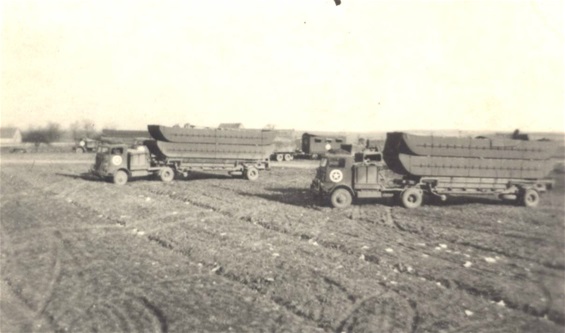 The 85th conducted many motor movements throughout Southern France in support of the push to drive the Germans out of France
The 85th conducted many motor movements throughout Southern France in support of the push to drive the Germans out of France
First Death by Drowning
On the morning of 23 September 1944, a utility power boat was being used by the 344th Engineer (GS) Regiment to transport men and materials from the banks to the damaged piers of the bridge. The safety
line connection on the boat started to slip and the boat started to get out of control. The safety man called for help to hold the line. Five men rushed to the bow of the boat to hold the safety cable. This sudden shift in weight caused the boat to be swamped
and all men were washed overboard. Pvt. Kucera of this battalion and one member of the 344th Engineeers were drowned. The body of Pvt. Kucera was recovered eight days later and buried at an American Cemetary, St. Juan, France.
On 21 September 1944, the battalion received a work order from the Engineer Section, Seventh Army to repair the German Ponton Equipment in vicinity of Le Loges Neuf and to move the repaired equipment to nearest loading point on Valence-Lyon
railroad line. Lt. Perrin with a detail from “B” Company was given the assignment.
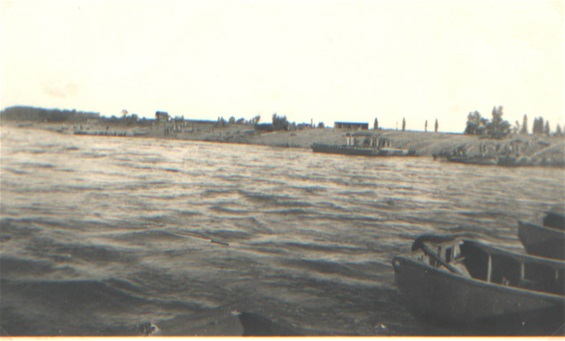 The swift currents of the rivers in France would claim two lives of the 85th Battalion
The swift currents of the rivers in France would claim two lives of the 85th Battalion
The Crossing Schools
 Bivouac area at Camp de Valbonne 9/26/44
Bivouac area at Camp de Valbonne 9/26/44
The battalion received orders onthe 23rd of September from the Engineer Section, Seventh Army to provide equipment and to supervise the training of one battalion of the 36th, 40th and 540th Engineer Regiments
in a stream crossing school located at Camp de Valbonne on the Rhone River.
The following day, plans were made to contact all details that were out on different jobs as to the change in plans
and the location of bivouac area.
The mission of the 85th Engineer Heavy Ponton Battalion was to instruct Engineer units, ordered to the school by the Army Engineer, in the operation of river
crossing equipment in swift currents. The Rhone River was selected as a training site because the average current of 7 feet per second closely resembled the speed of the current on the Rhine River.
Headquarters
and Service Company, on 25 September 1944 moved by motor convoy from vicinity of La Vielle Loye, France and arrived at Camp de Valbonne at 1500. The distance traveled was 110 miles. Company “B” moved on 26 September and Company “A”
on 27 September 1944.
During the period 26 September to 29 September 1944, the battalion was engaged in the preparation of training sites, schedules and bivouac areas for units which were to
arrive at the school.
The training at the school was to consist of the following: 1. The construction and operation of the 25 ton Heavy Ponton Bridge. 2. The construction and operation of Infantry
Support Rafts and 25 ton Ponton Rafts. 3. Operation of Motor Powered Assault Boats and Storm Boats. Experiments for stream crossing in fast currents were to be conducted. Company “A”, 84th Engineer Camouflage Battalion was to train in the construction
of a dummy 25 ton ponton bridge. The 69th and 78th Chemical Smoke Generator Companies were to furnish smoke cover for river crossing operations.
Preparations were made for experimental crossing
of 2-1/2 ton DUKWs in currents up to 7 miles per hour.
At 1300 29 September 1944, the training of Company “D”, 540th Engineers, Company “E”, 40th Engineers was started
in 25 ton Heavy Ponton Bridge. Company “A”, 36th Engineers started 25 ton Heavy Ponton Bridge training at 0730, 30 September 1944.
On the first day of October the 147th Quartermaster
Dukw Battalion and Companies E and F of the 540th Engineer Combat Regiment reported to the school for training.
At 0730 on the second of October the training began of Companies E and F of the
540th Engineer Combat Regiment in the operation of motor powered assault boats, storm boats and the construction and operation of rafts.
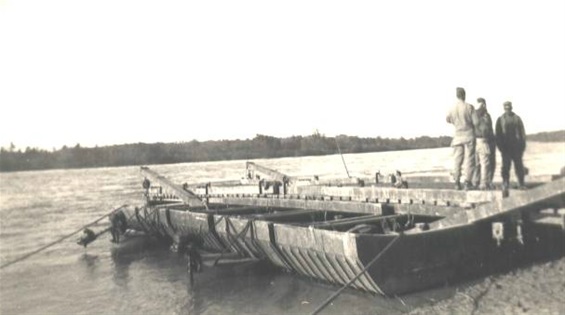 Four boat ponton raft
Four boat ponton raft
Close Call on the Rhone
- 10/14/44 Rommel commits suicide. On the afternoon of the second of October a power utility boat with a boat crew consisting of members of the
S-3 Section of this organization were looking for a channel in the river which would make possible the communication between the various training sites by boat. Upon reaching the dukw site it was found that a dukw was operating in the river without the use
of a maneuver cable. The dukw was carried by the swift current against a rock in the middle of the river. The dukw turned on its side and began to sink. Two of the four men in the dukw held on to the side of the partly submerged craft. The other two occupants
were thrown from the dukw and were floating downstream with the current. While the boat manned by members of the S-3 Section started out to rescue the men who were floating downstream another 85th Engineer utility boat commanded by Lt. Reed rescued the men
holding on to the dukw. The S-3 boat finally caught up with the two men and pulled them out of the water about one-half mile downstream from the scene of the accident. The two men rescued were Lt. Col. Sampson and Major Peters, the Commanding Officer and Executive
Officer respectively, of the 147th Quartermaster Dukw Battalion. After the rescued men were brought to shore the boat proceeded downstream. After traveling serveral minutes the boat hit a submerged rock causing the hull to be torn. The crew managed to beach
the boat, thereby reaching shore safely. The boat, a captured German craft, was lost and could not be recovered.
On the 5th of October Companies B and C of the 36th Engineer Combat Regiment reported
to the school for training. The training of Companies E and F of the 540th Engineer Combat Regiment was completed.
A verbal order was received from Seventh Army, through Sixth Army Group Headquarters,
to send 16 tractors and semi-trailors to the Engineer Depot 250 at Marseille, France. These vehicles were to haul 25 ton ponton equipment from the depot to the school. A written message dated 0900-A 6 Oct 1944 was later received confirming the verbal order.
On the sixth of October Companies B and C of the 36th Engineer Combat Regiment began their training at the school. On the 8th of October Company A of the 36th Engineer Combat Regiment, Company E of the
40th Engineer Combat Regiment and Company D of the 540th Engineer Combat Regiment completed their training period of the 25 ton ponton bridge. Companies B and C of the 36th Engineer Combat Regiment completed their training on the 9th of October at which time
the Second and Fourth Companies of the 101st Engineer Regiment of the French First Army began their training in construction of the 25 ton heavy ponton bridge. Their training was completed on the 17th of October.
 Utility boat
Utility boat
Training the French
 smoke cover was given by the 69th and 78th Chemical Smoke Generator Companies.
smoke cover was given by the 69th and 78th Chemical Smoke Generator Companies.
At 1300 on the 11th October a special demonstration of stream crossing equipment was given for a group of officers representing the Engineer Section of Seventh Army. The demonstratioin included the use
of storm boats, motor powered double assault boats, five ponton infantry support rafts and the double ramp five boat heavy ponton raft, class 40. During the demonstration, smoke cover was given by the 69th and 78th Chemical Smoke Generator Companies.
The 147th Quartermaster Dukw Battalion demonstrated the use of 2-1/2 ton Dukws in swift currents and methods of this craft landing under various shore conditions.
Lt. Col. Polich of th Engineer Section of Seventh Army demonstrated an expedient method of erecting a maneuver cable developed at the school.
On the 12th of October 1944
the First and Third Companies of the 101st Engineer Regiment (French) started training with storm boats, motor powered assault boats and construction and operation of rafts.
On the 16th of October
a power utility boat operated by Company B of this organization was used to aid a power ponton which had been forced against the upstream side of the ponton bridge being constructed by the French Engineers. The current also forced the power boat against the
bridge and it could not free itself of its own power. Being broadside of the current the upstream gunwale began to tip downward and efforts to free the boat caused it to ship water and sink. All attempts to locate and recover the boat failed.
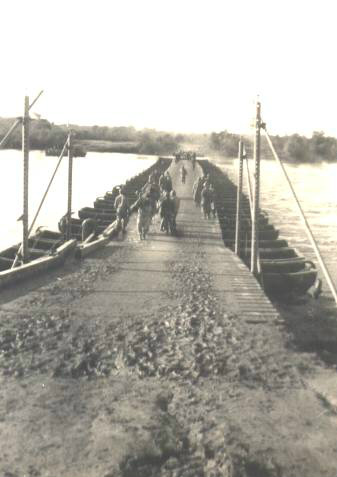 Heavy ponton bridge across the Rhone
Heavy ponton bridge across the Rhone
Second Death by Drowning
On the 29th of October a detail was working at the dukw site which involved the use of a two boat ponton raft, a power utility boat and a motor powered double assault boat. At this site a maneuver cable
was stretched across the river. While working above the cable the outboard motor failed in the double assault boat causing the boat to drift against the cable. In trying to free the boat from the cable the operator, Pfc. Frank N. Niciforo, and the boat were
thrown upstream about 20feet by the snapping of the cable. Pfc. Niciforo tried to swim for shore above the water but the current carried him below the maneuver cable where he went under the water. He rose to the surface about 50 feet from the cable but disappeared
again for the last time.
On the 22nd of October the Battalion received a letter from Headquarters Seventh Army dated 25 September 1944, subject: Assignment Status of Units. This letter relieved
this organization from assignment to AFHQ and attachment to SOS NATOUSA for supply and assigned the Battalion to Seventh Army effective 0001-B hours.
This Battalion received verbal orders from
the Engineer, Seventh Army to supply a detail to organize and operate a floating Bridge Depot at the railroad yards located at Girancourt, France. 1st Lt. Graves and 2nd Lt. Isenberg with a detail of 18 enlisted men were given this assignment and departed
from Valbonne for Girancourt at 1200 hours 25 Oct 44.
The operation section of the Battalion departed from Camp Valbonne at 0930 hours 29 Oct 1944 by motor, to establish the advance CP and take
charge of the operation of the Floating Bridge Depot. - 10/30/44 Last use of gas chambers at Auschwitz.
On 30 Oct 44, Headquarters and Service Company
minus the Service Platoon made preparations for road movement. Companies A and B supplied equipment and personnel to assist Lt. Col. Polich in experimental river crossing work.
On the 31st of
October at 1030 hours, Headquarters and Service Company less Service Platoon left Camp Valbonne by motor convoy and proceeded to the vicinity of Dole, France. Arrived there at 1600 and established overnight bivouac. Distance traveled 120 miles.
On the first of November 1944, at 0800 hours, Headquarters and Service Company less the Service Platoon departed from vicinity of Dole, France by motor convoy and proceeded north to the vicinity of Girancourt,
France, arriving there at 1500 hours. The men were housed in buildings of a Socony Gas plant which was partially destroyed by fire. Company B of this organization made preparations for their departure from Camp Valbonne.
On the 2nd of November 1944 at 1000 hours, Company B left Camp Valbonne by motor convoy and proceeded to the vicinity of Dole, France. They arrived there at 1600 hours and established an overnight bivouac. Distance traveled that day
was 120 miles.
On the 3rd of November 1944 at 0800 hours, Company B departed from the vicinity of Dole, France by motor convoy and proceeded north to the vicinity of Altoncourt, France arriving
there at 1500 hours. Distance traveled that day was 120 miles.
On the 4th of November 1944, this organization received a message from Col. R. D. King, Engineer Section, Seventh Army, to send
two officers and eight enlisted men (preferably NCOs) to the Engineer base depot at Delta Beach, Marseille, France. The assignment was to locate 25 ton heavy ponton bridge equipage and stream crossing equipage and ship this equipment by rail to the bridge
depot operated by the 85th Engineer Heavy Ponton Battalion. This assignment was given to Lt. F. Y. Perrin, Lt. C. A. Graves and eight NCOs from Company B. They were to work at Marseille under Col. Gardes of the Seventh Army Engineer Section.
Lt. Perrin and Lt. Graves with their detail departed at 0800 hours on 6 November 1944. They were given two C&R vehicles with drivers for transportation.
Lt. Karwales from Company B on the 8th of November 1944 was given the assignment of constructing a bailey bridge on highway GC 39 to replace a demolished bridge across the canal in the vicinity of Girancourt, France. A reconnaissance party was sent
out to the site to obtain the width of the span. The span was measured and found to be 60 feet. On the 9th of November 1944, Lt. Karwales and the 2nd Bridge Platoon of Company B spent the day transporting bailey bridge equipment from Depot E-206 and preparing
the site. The construction of a 70 foot bridge, class 40 D/S bridge began at 0800 hours 10 November 1944 and was completed at 1600 hours.
On the 8th of November 1944, Company A and Service Platoon
of Headquarters and Service Company, at 1000 hours, departed from Camp Valbonne, France by motor convoy and proceeded to the vicinity of La Veille-Loye, France. They arrived there at 1600 hours and established an overnight bivouac. Distance traveled that day
was 120 miles. The following morning at 0900 hours, Company A and Service Platoon departed from Le Veille-Loye, France by motor convoy and proceeded north to the vicinity of Dominartin, France arriving there at 1600 hours. Distance traveled that day was
120 miles.The Service Platoon rejoined H&S Company at 2100 hours. Company A, unable to drive their heavy vehicles off the road because of the soft ground caused by heavy rains, established a temporary bivouac on the existing hard standing road until a
new bivouac area could be found. On the 11th of November 1944, Company A departed from vicinity of Dominartin, France by convoy and proceeded to the vicinity of
Foret de Katimont, France. Distance traveled was approximately 7 miles.
Luneville
 French girl draws interest of the 85th in Luneville
French girl draws interest of the 85th in Luneville
The Battalion on the 13th of November 1944, at 1830 hours, received verbal orders from the Engineer, Seventh Army, to move the Battalion and bridge depot to the vicinity of Luneville, France. Company A
and bridge depot Detachment were alerted to move at 0900 hours, 14 November 1944.
At 0900 hours, 14 November 1944, Company A, the bridge depot Detachment and the Battalion operation section,
departed from the vicinity of Girancourt, France by motor convoy and proceeded to Luneville, France. The convoy arrived at the Lorraine Dietrich plant in Luneville at 1230 hours. Distance traveled that day was 50 miles. Meanwhile, H&S Company made preparations
for road movement and Company B operated the bridge depot at Girancourt, France. The Battalion and bridge depot were housed in five buildings of the Lorraine Dietrich plant in the town of Luneville.
On
the 15th of November, Company A and bridge depot Detachment started to unload ponton bridge equipment from railroad cars that were sent up from Marseille, and stock piled the equipment in the bridge depot. H&S Company departed from the vicinity of Girancourt,
France at 1000 hours by motor convoy and proceeded to Lorraine Dietrich plant in Luneville, France. They arrived at 1300 hours. Distance traveled that day was 50 miles. Company B prepared for road movement.
On the 16th of November, Company B departed from vicinity of Aitoncourt at 1400 hours by motor convoy and proceeded to Lorraine Dietrich plant arriving at 1700 hours. Eleven enlisted men were left behind to guard stream crossing equipment in bridge
depot at Girancourt railroad yard.
During the period 17 to 23 November 1944, the Battalion was engaged in unloading stream crossing equipment from the railroad cars that had arrived from Delta
Beach, Marseille and this equipment was stock piled in bridge depot. During this same period, equipment was being issued to the 85th Engr Hv Pon Bn, the 1553rd Engr Hv Pon Bn, the 540th Engr Regt, and the 40th Engr Regt.
On the 17th of November 1944, Lt. F. Y. Perrin and 18 enlisted men received the assignment to train Company A of the 540th Engr Regt in the construction of the standard five boat ponton raft. This assignment was completed on 22 November
1944.
On the 22nd of November 1944, the Battalion received orders from Col. R. D. King, Engineer Section, Seventh Army, to send three 5/6 ton truck tractors with trailers and report to the XV
Corps bridge depot. The vehicles were used to haul ten I beams for a bridge that was being constructed by the 1109th Engineer Combat Group. The equipment was hauled from XV Corps bridge depot in Luneville to bridge site at Heming, France.
On the 24th of November 1944, the storm boat section of H&S Company was placed on temporary duty with the 540th Engineer Combat Regiment for the initial crossing of the Rhine River. At 0900 hours, Lt. Isenberg and
twenty enlisted men with eight storm boats, eight 50 HP outboard motors and two 2-1/2 ton trucks with pole type trailers moved to the 540th Engineer Combat Regiment.
At 1545 hours on the 25th
of November 1944, the Battalion received Operation Instruction Number 19, Headquarters Seventh Army, dated 24 November 1944, classified Secret, that this organization, effective 0600A 25 November 1944 would be prepared to move on six hours notice to an area
designated by the Commanding General of XV Corps. The Battalion was attached to the 540th Engineer Combat Regiment for this operation. Companies A and B were ordered to make preparations to move on six hours notice. The two companies were ready to move by
1700 hours, 26 November 1944. The morning of the 27th of November 1944, word was received that the Battalion was taken off the alert until further notice. On the 28th of November 1944, Lt. Isenberg with detail and equipment returned to the 85th Engineer’s
bivouac area.
The 540th Engineer Combat Regiment and the 40th Engineer Combat Regiment were ordered to turn in all stream crossing equipment to the bridge depot. This equipment was stock piled
in the vicinity of Foret Demaniale, France and a 24 hour guard consisting of 12 enlisted men was put around this area.
On the 29th of November 1944, the Battalion received verbal orders from
the Seventh Army Engineer to send one officer and necessary personnel with two 5/6 ton truck tractors and trailers to haul captured enemy bridge material from Strasbourg, France to an Engineer depot located in Saverne, France. Lt. Perrin and eight enlisted
men from Company B received the assignment.
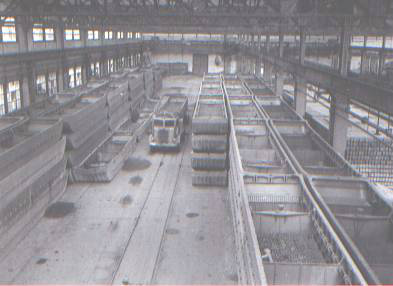 The Battalion and bridge depot were housed in five buildings of the Lorraine Dietrich plant in the town of Luneville.
The Battalion and bridge depot were housed in five buildings of the Lorraine Dietrich plant in the town of Luneville.
The Soldiers Medal
On 6 December 1944 hours, “The Soldiers Medal” was awarded to Captain Nagel, Technical Sergeant Citera, Staff Sergeant Feldman, and Technician Fifth Grade Mitchell. The medals were presented
by Brigadier General Davidson, Seventh Army Engineer at at battalion formation. See attached photographs.
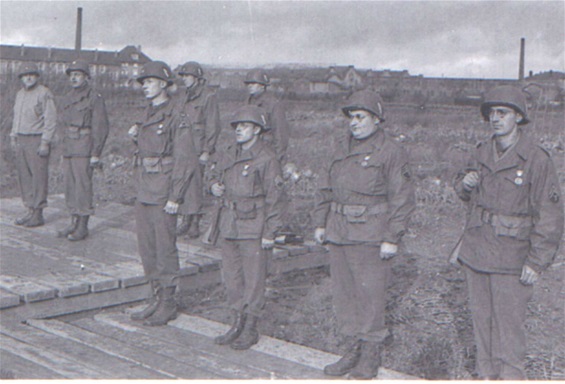 Commanding General of the 7th Army Engineer Gar Davidson awards the Soldiers Medal to the following members of the 85th: Capt. Nagel, TSGT. Citera, STFSGT. Feldman, T5 Mitchell, on 12/6/44 at Luneville, France. The Soldiers Medal is the highest medal awarded by the Army for bravery not involving contact with the enemy. The performance must have involved personal hazard or danger and the voluntary risk of life under conditions not involving conflict with an armed enemy
Commanding General of the 7th Army Engineer Gar Davidson awards the Soldiers Medal to the following members of the 85th: Capt. Nagel, TSGT. Citera, STFSGT. Feldman, T5 Mitchell, on 12/6/44 at Luneville, France. The Soldiers Medal is the highest medal awarded by the Army for bravery not involving contact with the enemy. The performance must have involved personal hazard or danger and the voluntary risk of life under conditions not involving conflict with an armed enemy
12/44 to 1/45
The battalion received orders to maintain highway D-9 from Bayon to Luneville on 6 December 1944 at about 2000 hours.
On 15 December 1944
the battalion received orders to maintain highways N-4 between Luneville and Domevre and N-392 from junction N-4 to Badonville.
In compliance with telephone conversation between Colonel King
and Captain Nagel, two power boats and operators were sent to the 117th Calvary Reconnaissance Battalion for operation. The boats were to be used for reconnaissance work and were supplied from reserve boats stored in the Floating Bridge Depot. - 12/16 to 12/27/44 Battle of the Bulge in the Ardennes. - 12/17/44 Waffen SS murder 81 POW's at Malmedy. - 12/26/44 Patton relieves Bastongne.
On 25th December 1944 the battalion received message #604 from the Engineer Section Seventh Army to furnish four power utility boats and four operators to report to the Commanding Officer of task force
“Harris”, located at Oberhoffen, France. The power utility boats for this operation were obtained from the Floating Bridge Depot. On the same date, the battalion received a letter from Headquarters Seventh Army dated 23 December 1944, attaching
the 763rd Engineer Dump Truck Company, less one platoon to this organization for operations.
In compliance with telephone conversation between Major Williams and Captain Nagel on 28 December
1944, the battalion started a Bailey Bridge Depot in the vicininty of Luneville. Forty-two truckloads of bridge were unloaded at the depot this date.
Sergeant Michael J. Hardick of this organization
invented a screw type jack to replace the hydraulic type used on the 22 HP outboard motor stern bracket attachment. This new screw type jack through various tests and checks has been found to be more practical and useful than the hydraulic jack. A letter was
written to the Chief of Engineers by Lt. Col. Perdue giving complete details of the screw type jack and recommending that in future manufacture that this jack replace the hydraulic type.
Throughout
the entire month of December the battalion has been engaged in operating and maintaining a Floating Bridge Depot. Carpenters have been at work all through the month repairing storm and assault boats. Eighteen enlisted men of the 469th Engineer Maintenance
Company were attached to this organization to check and recondition 22 HP and 50 HP outboard motors. - 1/1 to 1/17/45 Germans withdraw from the Ardennes.
On
5 January 1945 the battalion received orders from the Engineer section, Seventh Army to give certain highways of our road maintenance network first priority and to have a wrecker patrol the highways to clear the roads of wrecked vehicles.
The battalion received verbal orders from Lt. Col. Kraft, Engineer Section, Seventh Army relieving the battalion from the maintanance of highway N-4 from Luneville to Elamont, France, on 8 January 1945.
On 9 January 1945 the battalion received a message from Engineer Section, Seventh Army that two road graders would be attached to the battalion from Company B, 378th Engineer Battalion. The message further stated
that they would be returned to the 378th Engineers on 16 January 1945. Later in the day additional orders were received to send one road grader to the 2755th Engineer Battalion on the 13th of January 1945. Company B of this battalion used both graders for
two days clearing the roads of snow drifts and thereby keeping the highways open for military traffic. On 13 January 1945 one grader was released to 2755th Engineers and Company B continued to use the other one until the 16th of January 1945.
On 14th of January 1945 the battalion received Area Assignment Overlay No. 8, Headquarters Seventh Army, Office of the Engineer, dated 12 January 1945 assigning the maintanance of highways N-4 from Dombasle
to Luneville and N-59 from Luneville to Baccarat. All previous road assignments were discontinued. The maintenance of these highways consisted of a wrecker patrol, clearing snow and performance of any other necessary engineer work. Two cubic yards stock piles
of sand were placed at intervals of 100 yards along the road. In event of freezing weather the sand from the stock piles was to be spread across the road. - 1/16/45 U.S. 1st and 3rd Armies link up after a month long
separation during the Battle of the Bulge. - 1/17/45 Soviet troops capture Warsaw.
In compliance with verbal orders from Colonel King, Engineer Section,
Seventh Army on 17 January 1945, Company A was ordered to unload all ponton equipage from their vehicles and be prepared to transport supplies for Engineer Depots within three days. On the morning of the 20th of January 1945, Company A started to haul lumber
and other supplies from Epinal to Luneville and continued to haul supplies from various depots in France to Luneville throughout the month.
In compliance with telephone conversation from Engineer
Section, Seventh Army, later confirmed by written messages, on 19 January 1945, the battalion dispatched one 7-1/2 ton Prime Mover to Engineer Depot E-255 at Dijon, France. The vehicle was used to haul a D-7 Dozer and 20 ton trailer to XV Corps.
On 23 January 1945 the battalion received Area Assignment Overlay No. 9, Headquarters Seventh Army, Office of The Engineer, dated 22 January 1945, relieving the organization from all road maintenance.
At 1800 hours 24 January 1945 the battalion was relieved of all road maintenance by the 343rd and 344th Engineer General Service Regiments. - 1/26/45 Soviet troops liberate Auschwitz.
In compliance with telephone conversation between Major Williams and Lt. Campbell on 27 January 1945, the battalion dispatched three Prime Movers to Engineer Depot E-210 at Dijon, France to haul three D-7 dozers with trailers to Engineer
Depot E-210 at Luneville.
On 29 January 1945, Company B was attached to VI Corps for operations. At 1000 hours, same date, the battalion ordered Company B to unload all ponton equipage and prepare
to reload with Bailey Bridge equipment at Engineer Depot E-210 and E-206. Upon completion of loading, the company commander was instructed to move to the vicinity of Savarne, France and report to the VI Corps Engineer where he would receive further orders.
On 30 January 1945, the first bridge platoon of Company B this battalion upon completion of their loading, departed from Luneville at 1700 hours by motor convoy and proceeded to Steinbourg, France, to
establish an advance C. P. for the company. The convoy was commanded by Lt. Perrin.
Headquarters platoon and the Second Bridge Platoon continued to make preparations for movement.
Throughout the entire month of January, the battalion has been engaged in operating and maintaining a Floating Bridge Depot.
Company B this Battalion
had been ordered by Headquarters Seventh Army to be attached to VI Corps for the purpose of operating a Bailey Bridge Train.
Hauling Lumber
 Mel O'Barr at French lumber mill
Mel O'Barr at French lumber mill
On the 25th of January 1945, Capt. Brand, this Battalion, was given an assignment from Engineer Section, Seventh Army to contact lumber mills to supply Engineer Depots with approximately 350,000 board feet
of lumber in a period of three months. Later the Engineer Supply Section, Seventh Army, found that the requirements for lumber previously required was inadequate and a new quote was set up for approximately 1,750,000 board feet for the three month period.
This involved quite a problem because the French lumber mills had no way to haul the rough timber from the forest. Captain Brand overcame this by making special arrangements for hauling the timber from the forest by using tractors and trailors of Company A
this Battalion.
During the month of February 1945, 25 lumber mills were placed under contract to supply timber for the Engineer Depots and for the same period, Company A this Battalion hauled
to depots from the mills approximately 621,000 board feet of lumber.
- 2/4 to 2/11/45 Roosevelt, Churchill, Stalin meet at Yalta.
 Add photo text
Add photo text
Various Assignments 2/6/45 to 3/16/45
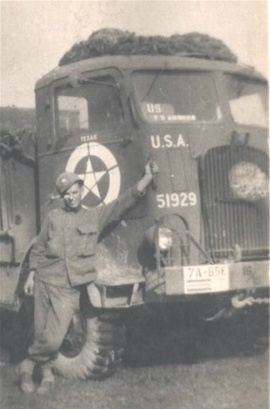 The 85th's Mack trucks were kept busy in France
The 85th's Mack trucks were kept busy in France
In compliance with telephone conversation between Major Lazar and Capt. Porter on 6 February 1945, two Utility Power Boats and operators were sent to Col. Darling, VI Corps. The Boats were to be used for
operation by 1117th Engineer Combat Battalion in vicinity of Reichstett, France.
In compliance with telephone conversation from Engineer Section, Seventh Army, later confirmed by written message
on 7 February 1945, the Battalion dispatched one D-7 Angledozer with three operators to Engineer Depot E-210. The angledozer was used to maintain the road in depot area.
In compliance with telephone
conversation between Capt. Miller, Engineer Supply Section, Seventh Army and Capt. Nagel on 8 February 1945, the battalion dispatched four truck tractors with trailors to Diedendorf, France. The vehicles were to haul 25-ton ponton equipage to Floating Bridge
Depot. The pontons were recovered from a stream and proved to be beyond repair.
The battalion has been engaged in operating and maintaining a Floating Bridge Depot throughout the entire month
of February 1945.
Additional Ponton Equipage was shipped by rail from the base section to the Depot.
The following is the history
of Company B this battalion while attached to VI Corps.
At 0045 hours, 3 February 1945, a messenger arrived with the following message transmitted through Capt. Sheffield of the 2749th Engineers,
“Alert the following to leave the area in thirty minutes to one hour: 10 panel loads, 6 decking loads, 2 ramp loads, and one accessory load. Capt. Hassler or his representative will guide you to the 111th Engr. C.P.” The first platoon moved from
the area at 0230 hours and proceeded to Marienthal. The bridge was not needed immediately and the platoon was ordered to stand by for further instructions. Their site was the division bridge dump.
On
4 February 1945, some of the equipment transported by the first bridge platoon was unloaded and used for a bridge by the 40th Engineers. The remainder was held on the trucks for future use.
On
5 February 1945 the following verbal order was received from Lt. Col. Darling of VI Corps Engr Section at 1515: “Transport one bridge to the 540th Engrs at Lutzelbourg for training purposes.” Lt. Nesbitt of the 540th Engrs appeared and guided the
second bridge platoon to the bivouac area at Lutzelbourg. The platoon left the company area at 1610 hours.
On the 6th of February, the first bridge platoon unloaded the remainder of their Bailey
Bridge at the Division Bridge Dump at Marienthal and returned to the company area at 1400 hours. Because of the necessity of completing road work, the 540th Engineers were unable to start training immediately with the Bailey Bridge. Consequently, the trailers
were completely unloaded at Lutzelbourg, the training site, and the second bridge platoon returned to the company area at 1700 hours.
February 8, 1945 the company commander of Company A, 31st
Engineers requested use of the R-4 for road work in the vicinity of Steinbourg. Dozer and operator dispatched for the balance of the day. Continuation of maintenance of vehicles in preparation of possible work hauling lumber. Six men dispatched to Luneville
area to inventory the bridge equipment left in Luneville old area. This was in reply to a Battalion order transmitted by radio. The D-7 was also put to work constructing a new entrance road to the bivouac area. The original road was made impassible because
of the heavy rains and traffic.
On 9 February 1945, the R-4 and D-7 with operators continued work on the roads. Lt. Col. Darling requested that a German inboard motor boat with trailer be picked
up from its site at Stambach and brought to company area. Lt. Karwales and a detail from the second platoon, accompanied by the H/S Co crane, accomplished this mission. Lt. Graves, Company A this Battalion, appeared with 15 semi-trailors loaded with bridge
timbers. These were to be unloaded at Engineer Depot 207, Saverne.
February 10, 1945 Company A semi-trailors unloaded at Depot 207 and returned to Luneville. R-4 continued assisting Company A,
31st Engineers with road work. A detail worked on the road into company bivouac area. Mechanics and inboard motor operators checked over the German boat and found that many vital parts were missing. Lt. Col. Darling was informed that the boat was beyond repair
by this unit.
The 11th of February, upon orders of Capt. Reiner, Engineer Section, VI Corps, the company prepared to move from its present site to make room for an Ordnance unit. No suitable
area could be located for a bivouac. Company moved to the vicinity of Haegen where the vehicles were parked along the road. Tents were pitched in a nearby field. The company left the old area at 1500 and arrived by motor march of 7 miles at new area at 1600.
- 2/13 to 2/14/45 Dresden is destroyed by a firestorm after Allied bombing.
From 15th to 17 February, Company B worked on roads in the neighborhood of the bivouac.
Ditches were cleaned out and culverts were repaired.
February 18, 1945, orders were received from VI Corps to load the German power boat and its trailor for transportation to the 460th Engineer
Maintenance Company located at Rambervillers. The two 16-ton flat bed trailers were utilized for this transporting.
On the 19th of February 1945, General Palmer, Chief of Staff, VI Corps, inspected
the area. - 2/22/45 Donald R. O'Barr is KIA in France near Spicheren Heights, just 50 miles north of his twin brothers Milt and Mel in the 85th.
On
20th to 22nd February, general maintenance of vehicles and equipment was constituted. Reconnaisance was made of lumber hauling in the vicinity of Abschewiller because of the possibility that some trucks might be used for this work. February23, 1945, an inspection of sanitation, mess and supply and personnel records was made by Lt. Col. Hoff of the Medical Corps and Lt. Col. Pennycuick of the Inspector General’s
Department. On verbal orders of Col. Thomas, VI Corps Engineer, 14 panel, 2 decking, 2 ramp, and 1 accessory loads were loaded on semi-trailers at the 378th Engineer Depot in Saverne. Of these, 4 panel, 4 decking, 1 ramp and 1 accessory loads were delivered
to the 1271st Engineers at Hohfrankenbeim. The remainder of the bridging equipment remained on the semi-trailors to be transported where and when VI Corps Engineer Section might direct.
February 28, one 6 ton truck and the R-4 tractor was dispatched
to the First Bridge Platoon of Company A this battalion, located at Barville-Bas.
On the 1st of March 1945 the Battalion received orders from The Engineer Seventh Army to prepare to train River Crossing Teams from the 540th Engineer Combat Group.
On the 2nd of March 1945 Major Porter (then Capt) made a reconnaissance for an RCT training site in the vicinity of Bures, France. Lake Parroy was selected for training. On this same date movement orders received from Headquarters Seventh Army instructed
Company B this Battalion to move from Haegen, France to vicinity of Bures, France. Effective upon arrival at destination Company B was relieved from attachment to VI Corps. Captain Parker was instructed to move the company to Moncel, France and establish bivouac.
On the 3rd of March 1945 the Battalion in compliance with instructions received from Engineer Supply Section, Seventh Army issued to the 540th Engineer Combat Group and 40th Engineer Combat Group river crossing equipage from the Luneville Floating
Bridge Depot. This equipment was to be used for training river crossing teams.
On the 5th of March 1945, this Headquarters received a letter from Headquarters Seventh Army dated 2 March 1945 attaching the Battalion to the 540th Engineer Combat Group
for operations only. - 3/7/45 Allies take Cologne and establish a bridge across the Rhine
at Remagen.
On the 9th of March 1945 in compliance with verbal orders from the Engineer Seventh Army, a test load of ponton equipage was made on ten ton QM cargo trailers to determine whether two pontons would ride satisfactorily right
side up. (see photographs) The results were inspected and approved by General Davidson, The Engineer, Seventh Army.
On the 10th of March 1945 this Headquarters received a letter from the 540th Engineer Combat Group attaching Company A 2833 Engineer
Combat Battalion and Company A (less 1 platoon) 84th Engineer Camouflage Battalion to the Battalion for operational control. Company A 2833rd Engineer Combat Battalion assisted in the operation of the Floating Bridge Depot.
During the period 6 March
to 16 March 1945 the Battalion engaged in the operation of River Crossing Team School, instructing personnel of the 540th Engineer Combat Group on Lake Parroy in the vicinity of Bures, France.
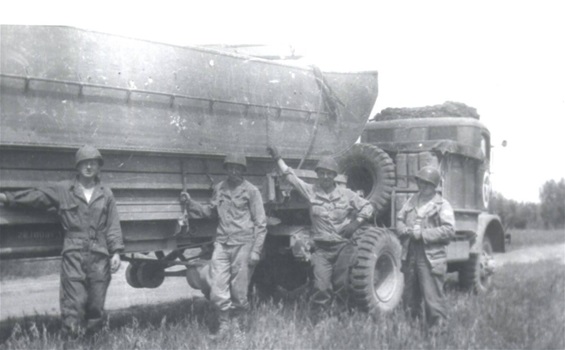 Many miles were logged by the 85th in support of the 7th Army's push through Southern France
Many miles were logged by the 85th in support of the 7th Army's push through Southern France
Meurthe River
 Officers Hunt and Brand at the Meurthe River bridge
Officers Hunt and Brand at the Meurthe River bridge
During the period 12 March to 15 March 1945, Company A this Battalion conducted a refresher course in the construction of 25 ton Heavy Ponton Bridge for members of this Battalion and Company A 2833rd Engineer
Combat Battalion on the Meurthe River in the vicinity of St. Nicholas, France.
On the 17th of March 1945 a message received from the 540th Engineer Combat Group placed the Battalion on a 24 hour
alert with instructions to make a reconnaissance of a forward area and find a tentative bivouac for the Battalion and attached units. On the following day Lt. Perrin of Company B this Battalion made a reconnaissance in the vicinity of Rahling, France.
On the 18th of March 1945 the 3886th Quartermaster Truck Company was attached to the Battalion for operation. 45 QM trucks were loaded with 25 ton ponton equipage which was to be hauled for the Battalion.
At 0600 hours 19 March 1945 the Battalion was relieved from the operation of the Floating Bridge Depot in Luneville, France by the 1144th Engineer Group. At 0610 hours the Battalion and attached units
composed of 13 march units moved from Luneville, France and proceeded northeast to 1/2 mile north of Schmitville, France. Arrived at 1330 hours and established bivouac. Distance traveled 51 miles.
On
the 21st of March 1945 one platoon from 838th AAA Battalion was attached to the Battalion to protect the column and area. One squad was attached to Company A and one to Company B this Battalion.
At
2100 hours 22 March 1945 the Battalion received a radio message from Major Looney, S-3 540th Engineer Combat Group informing the Battalion and attached units to be ready to move on three hours notice.
In compliance with message received from 540th Engineer Combat Group at 1845 hours 23 March 1945 the Battalion moved by motor company via Rohrbach, Bitche and Zweibrucken to 1 mile east of Eisenberg, Germany, arrived at 0500 hours 24 March 1945 and
established bivouac. Distance traveled 85 miles.
|
|
 |
|
|
|